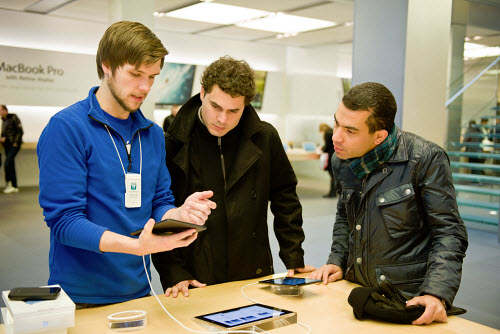Apple released its newest tablet version, the iPad Air, on November 1, 2013. Based on the success of Apple’s iPad 4, iPad mini, and earlier tablets, the company has high hopes for the success of the iPad Air model. The tablet is based on the company’s MacBook Air, a lighter, more portable version of the MacBook laptop computers.
With the subsequent release of the iPad mini with Retina display (iPad mini 2) tablet, the company has a complete offering of tablet models for the consumer to choose from. More aggressive competition from makers like Samsung (with the Galaxy), Amazon (with the Kindle), and smaller makers of low-cost devices in the $40 to $100 range will put pressure on the iPad Air to meet and exceed its sales expectations going into 2014.
iPad Air Impact on Sales
Apple’s release of the iPad Air and iPad mini 2 were part of a strategy to boost lagging overall tablet sales. Through the first three quarters of 2013 (prior to the November release of the iPad Air), sales of all iPad models were at 57 million, up 32 percent from the same year-to-year sales in 2012. Sales for the fourth quarter of 2013 are not expected to grow at all, based on analyst’s estimates, coming in at an aggregate of 13 to 14.53 million units sold. One analyst, Chuck Jones of Forbes Magazine, is holding out that the release of the iPad Air and iPad mini 2 will boost fourth-quarter 2013 sales to around 27.5 million iPad units, representing an increase of 96 percent over fourth-quarter 2012 totals.
Comparative Sales Data for Apple Tablet Computers
The success of the iPad Air is already being challenged by Amazon’s Kindle Fire HDX 8.9. In a recent series of television ads, Amazon takes dead aim at Apple, comparing the two products side by side. A look at the models signals some concerns for the iPad Air against claims about its resolution (267 pixels per inch) and weight (469 grams for the gray model and 478 grams for iPad Air’s silver model). The newer version Kindle has a resolution of 339 ppi and a weight of 386 grams, which is 18 percent lighter than the lightest Air model. Although the Kindle retails for less than the Air ($229 versus $499), performance comparisons suggest that the Air may be a better machine for power users, while those with more casual needs may prefer the less expensive Kindle.
Projected Growth for the iPad Air
The tablet market has been dominated by Apple for years, ever since the inception of the first iPad model. This dominance has been taken away by the emergence of the Samsung Galaxy Tab and Galaxy 3 tablets. What will depress future sales of the iPad tablet overall and models like the iPad Air specifically will be its pricing strategy relative to its competitors. As competitor devices are made for less and sold on slimmer profit margins than Apple’s iPads, the debate comes down to comparative quality and price. If players like Amazon and Samsung can continue to match Apple’s innovations with less expensive, more lightweight, and fully functional devices, Apple’s current market share of 29.6 percent (down from 40 percent a year ago) will continue to fall, going to its rivals like Samsung, which has a current market share of 20 percent (up from 12 percent).
Byline
Christoph Mortensen is a freelance tech writer based in Tulsa, Oklahoma. Aside from the iPad Air, Christoph writes on the iPhone 5, accessories such as the kensington ipad keyboard case, popular Bluetooth keyboards, the Xbox One and other tech subjects as well.

 According to the report from Conlumino, approximately 60% of all tablets purchased in the UK in the last three months have been smaller than conventional tablet devices. The iPad Mini Retina and Google Nexus 7 have become the most popular of these small tablets. The majority of those purchasing small tablets claim they did so because they wanted a device that they could carry around more easily. These consumers are likely to use their tablets for mobile commerce and 60% said that they would be using their small devices specifically for holiday shopping.
According to the report from Conlumino, approximately 60% of all tablets purchased in the UK in the last three months have been smaller than conventional tablet devices. The iPad Mini Retina and Google Nexus 7 have become the most popular of these small tablets. The majority of those purchasing small tablets claim they did so because they wanted a device that they could carry around more easily. These consumers are likely to use their tablets for mobile commerce and 60% said that they would be using their small devices specifically for holiday shopping.